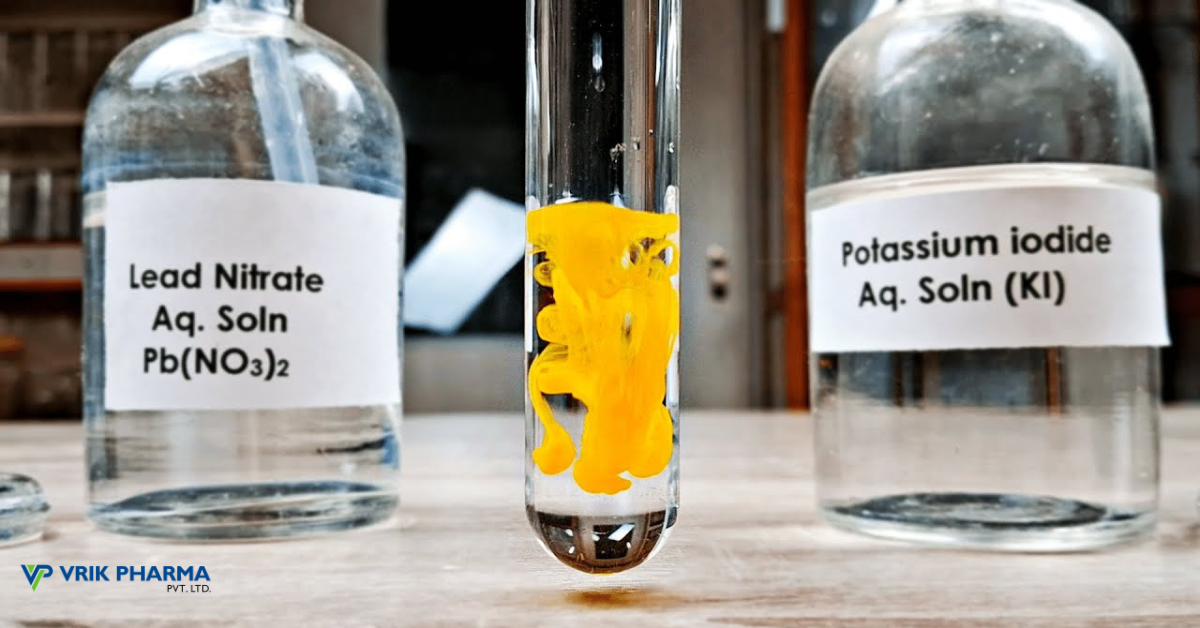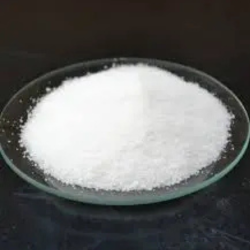
In the world of chemistry, some reactions are as fascinating to observe as they are to understand. One such classic experiment involves mixing Lead Nitrate solution and Potassium Iodide solution. This cheap reaction is not only appealing to the eye, but it also gives a strong illustration of the reactions of double displacement and precipitation.
We will discuss what occurs in this chemical reaction, the science involved in the chemical reaction and the application. So, let us go into details.
Understanding the Reactants
Before diving into the actual reaction, we should get a feel for what the individual compounds are:
Lead Nitrate (Pb(NO₃)₂)

Lead Nitrate is a soluble white crystalline solid that is able to dissolve in water. It is a lead salt normally applied in labs in chemical analysis and demonstrations. As a heavy metal salt, lead nitrate is toxic, and care should be taken to handle this salt.
Potassium Iodide (KI)

Potassium Iodide is a compound of potassium and iodine. Its high solubility in water and capability to react with some metal ions of metals make it extensively applicable in pharmaceuticals, radiation and chemical reactions, etc.
The Chemical Reaction
What Will Take Place When the Two Solutions Are Combined?
When an aqueous solution of Lead Nitrate is added to an aqueous solution of Potassium Iodide, a double displacement (or metathesis) reaction occurs. This means the cations and anions of the two reactants swap places, forming new compounds
Chemical Equation:
Pb(NO₃)₂ (aq) + 2KI (aq) → PbI₂ (s) + 2KNO₃ (aq)
Explanation:
- Lead nitrate releases Pb²⁺ that reacts with the I⁻ released by potassium iodide.
- Lead(II) iodide (PbI₂) is formed as a yellow precipitate.
- Potassium nitrate (KNO₃) remains dissolved in the solution.
Visual Observation: The Yellow Precipitate
The highlight of this reaction is the appearance of a bright and yellow solid, but this solid settles within a short time at the bottom of the container. This solid is lead (II ) iodide and is insoluble in water at room temperature.This visual is a spectacular difference, and hence this reaction is a common demonstration in classrooms as well as chemistry labs to show the features of precipitation reactions.
What is the Reason for this Response?
These rules of solubility and ionic interactions determine this reaction. Now, let us break it down:
- Double displacement Reaction: This is easily a known reaction whereby the ions are changed between two compounds.
- Precipitation of an Insoluble Salt: The solubility of lead iodide in water is very small, and this makes it precipitate out of solution in the form of a precipitate.
- Driving Force: A solid product (precipitate) is formed, and this is the driving force of this reaction.
Uses and Applications
Though this reaction can be primarily considered as educational, it also illustrates several important chemical concepts to be applied in many aspects:
1. Instructing Chemistry concepts
In this experiment, the students can visualise:
- Ionic compounds
- Precipitation reactions
- Double displacement reactions Double displacement reactions
2. Qualitative Analysis
Lead nitrate can be used in analytical chemistry to test the presence of iodide ions, and potassium iodide can be used to test lead ions. The presence of the two can be validated by the formation of yellow lead(II) iodide.
3. Pharmaceutical and Industrial Setting
In Vrik Pharma, where accuracy and chemical accuracy play an important role, knowing how compounds interact is useful in ensuring the safety of products produced, product regulation and quality control of drugs and chemical procedures and processes.
Safety Precautions
Although the reaction can be demonstrated safely because all conditions are under control, the reactants used are lead nitrate and potassium iodide, each needing care:
- Lead nitrate has severe health complications when it is swallowed or inhaled and is toxic.
- Even potassium iodide, which is relatively harmless in small doses, may induce allergies in certain people.
- The suitable advice is to wear proper protective gear, which includes gloves, goggles, and lab coats.
- The reaction should always be done in a fume hood or a well-ventilated laboratory.
- Dispose of the lead-containing waste in a proper manner, according to the regulations in your state on hazardous material handling.
Conclusion
An experiment performed between lead nitrate and potassium iodide is both visually stimulating and scientifically informative in the nature of ionic compounds reacting in aqueous solutions. The oxidation of lead(II) iodide into a bright yellow precipitate is a typical demonstration of the double displacement and precipitation reaction. Whether you’re a student, teacher or a member of the chemical field, this experiment is going to be very beneficial in terms of understanding how ions behave in solutions. Such principles of chemistry are important in Vrik Pharma because they are the foundation of all chemistry testing and pharmaceutical pills.
Know More Vrik Pharma
To learn more and to get more information on the chemistry, trends in pharmaceuticals and scientific explorations that connect theory to the real-world sphere, stay tuned to Vrik Pharma. Our commitment to quality and precision extends from our lab to your learning experience.
